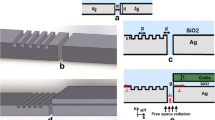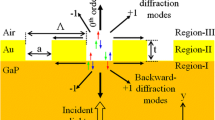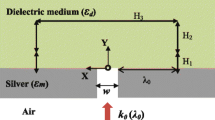Abstract
A method for the analysis of finding the conversion efficiency of the surface plasmon polariton in slit-groove structures is proposed and studied. The conversion efficiency of the surface plasmon polariton can be determined by measuring the intensities of light scattered at the slit and groove positions. To verify the usefulness of the proposed method, two rigorous simulations based on the finite-difference time-domain method were executed and the simulation results compared with previously reported data. One was to mimic the far-field imaging experiment in slit-groove structure and the other was to calculate the conversion coefficient directly in a single scattering structure. The SPP conversion efficiencies obtained from the two simulations were approximately 0.232 and 0.220 respectively, and these agreed with the reported data. The suggested method can be used regardless of the shape of the plasmon-generation structure; therefore, it is expected to be useful in a wide range of experiments with different scattering structures.




Similar content being viewed by others
References
T.W. Ebbesen, H.J. Lezec, H.F. Ghaemi, T. Thio, P.A. Wolff, Extraordinary optical transmission through sub-wavelength hole arrays. Nature 391, 667 (1998). https://doi.org/10.1038/35570
H. Ditlbacher, J.R. Krenn, A. Hohenau, A. Leitner, F.R. Aussenegg, Efficiency of local light-plasmon coupling. Appl Phys Lett 83, 3665 (2003). https://doi.org/10.1063/1.1625107
S.J. McNab, N. Moll, Y.A. Vlasov, Ultra-low loss photonic integrated circuit with membrane-type photonic crystal waveguides. Opt Express 11, 2927 (2003). https://doi.org/10.1364/OE.11.002927
A. Polman, Applied physics. Plasmon Appl Sci 322, 868 (2008). https://doi.org/10.1126/science.1163959
W.L. Barnes, A. Dereux, T.W. Ebbesen, Surface plasmon subwavelength optics. Nature 424, 824 (2003). https://doi.org/10.1038/nature01937
E. Ozbay, Plasmonics: merging photonics and electronics at nanoscale dimensions. Science 311, 189 (2006). https://doi.org/10.1126/science.1114849
Raether H (1998) Surface plasmons on smooth surfaces. In: Surface plasmons on smooth and rough surfaces and on gratings. Springer, New York
Y.Y. Teng, E.A. Stern, Plasma radiation from metal grating surfaces. Phys Rev Lett 19, 511 (1967). https://doi.org/10.1103/PhysRevLett.19.511
A.L. Falk, F.H.L. Koppens, C.L. Yu, K. Kang, N. de Leon Snapp, A.V. Akimov, M. Jo, M.D. Lukin, H. Park, Near-field electrical detection of optical plasmons and single-plasmon sources. Nat Phys 5, 475 (2009). https://doi.org/10.1038/nphys1284
L. Aigouy, P. Lalanne, J.P. Hugonin, G. Julié, V. Mathet, M. Mortier, Near-field analysis of surface waves launched at nanoslit apertures. Phys Rev Lett 98, 153902 (2007). https://doi.org/10.1103/PhysRevLett.98.153902
T. Iqbal, Coupling efficiency of surface plasmon polaritons: far- and near-field analyses. Plasmonics 12, 215 (2017). https://doi.org/10.1007/s11468-016-0252-z
A. Sierant, B.R. Jany, T. Kawalec, Near-field characterization of surface plasmon polaritons on a nanofabricated transmission structure. Phys Rev B 103, 165433 (2021). https://doi.org/10.1103/PhysRevB.103.165433
A. Taflove, S. C. Hagness, M. Piket-May, Computational electromagnetics: the finite-difference time-domain method (The Electrical Engineering Handbook, 2005)
D. Pacifici, H.J. Lezec, H.A. Atwater, All-optical modulation by plasmonic excitation of CdSe quantum dots. Nat Photonics 1, 402 (2007). https://doi.org/10.1038/nphoton.2007.95
D. Morrill, D. Li, D. Pacifici, Measuring subwavelength spatial coherence with plasmonic interferometry. Nat Photonics 10, 681 (2016). https://doi.org/10.1038/nphoton.2016.162
A. Neogi, C. Lee, H.O. Everitt, T. Kuroda, A. Tackeuchi, E. Yablonovitch, Enhancement of spontaneous recombination rate in a quantum well by resonant surface plasmon coupling. Phys Rev B 66, 153305 (2002). https://doi.org/10.1103/PhysRevB.66.153305
B. Wang, P. Lalanne, How many surface plasmons are locally excited on the ridges of metallic lamellar gratings? Appl Phys Lett 96, 051115 (2010). https://doi.org/10.1063/1.3304021
P. Lalanne, J.P. Hugonin, J.C. Rodier, Theory of surface plasmon generation at nanoslit apertures. Phys Rev Lett 95, 263902 (2005). https://doi.org/10.1103/PhysRevLett.95.263902
P. Lalanne, J.P. Hugonin, J, C, Rodier, Approximate model for surface-plasmon generation at slit apertures. J Opt Soc Am A 23, 1608 (2006). https://doi.org/10.1364/JOSAA.23.001608
R. Mehfuz, M.W. Maqsood, K.J. Chau, Enhancing the efficiency of slit-coupling to surface-plasmon-polaritons via dispersion engineering. Opt Express 18, 18206 (2010). https://doi.org/10.1364/OE.18.018206
H. Hu, X. Zeng, L. Wang, Y. Xu, G. Song, Q. Gan, Surface plasmon coupling efficiency from nanoslit apertures to metal-insulator-metal waveguides. Appl Phys Lett 101, 121112 (2012). https://doi.org/10.1063/1.4754137
A.L. Baudrion, F. de Léon-Pérez, O. Mahboub, A. Hohenau, H. Ditlbacher, F.J. García-Vidal, J. Dintinger, T.W. Ebbesen, L. Martin-Moreno, J.R. Krenn, Coupling efficiency of light to surface plasmon polariton for single subwavelength holes in a gold film. Opt Express 16, 3420 (2008). https://doi.org/10.1364/OE.16.003420
J.D. Jackson, Classical electrodynamics (American Association of Physics Teachers, New York, 1999)
Acknowledgements
This work was supported by funding from the Chungnam National University.
Funding
Not applicable.
Author information
Authors and Affiliations
Corresponding author
Ethics declarations
Conflict of interest
Not applicable.
Availability of data and material
Not applicable.
Code availability
Lumerical FDTD simulator.
Ethics approval
Not applicable.
Consent to participate
Not applicable.
Consent to publication
Not applicable.
Additional information
Publisher's Note
Springer Nature remains neutral with regard to jurisdictional claims in published maps and institutional affiliations.
Rights and permissions
About this article
Cite this article
Park, Y. Analysis of surface plasmon polariton conversion coefficient in slit-groove structure. J. Korean Phys. Soc. 80, 898–903 (2022). https://doi.org/10.1007/s40042-022-00419-9
Received:
Revised:
Accepted:
Published:
Issue Date:
DOI: https://doi.org/10.1007/s40042-022-00419-9




